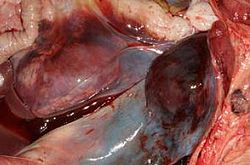African Swine Fever
Also known as: ASF — ASFV
Introduction
African Swine Fever (ASF) occurs after infection by the Asfarviridae family of viruses. ASF is a serious exotic virus that should not be confused with Classical Swine Fever although the signs are similar for the two diseases.
African Swine Fever is currently an exotic disease to the UK and is notifiable. The virus is spread either by direct contact with carrier pigs, by aerosol or from infected swill. It can also be transmitted by soft ticks in Africa. The virus is relatively difficult to eliminate and can persist on infected premises for months. Sub-acutely infected recovered pigs become antibody - positive carriers.
Clinical Signs
In the acute form of the virus, that is usually seen in Africa, signs may include nasal discharge, diarrhoea, enlarged lymph nodes and reddening of the skin, especially around the ears. Death usually occurs within 7 days.
In the subacute form of the virus that normally occurs in Europe, mortality is not as common, with only a 30 - 70% mortality rate. Survivors may lose body condition and have skin ulcers and joint swelling.
Diagnosis
It is important to be able to distinguish ASF from Classical Swine Fever (CSF) and Porcine Dermatitis and Nephropathy Syndrome (PDNS), as all three have similar clinical signs. Tests need to be performed to rule out the differentials.
At post mortem there may be widespread internal haemorrhage, as well as petechial haemorrhages under the kidney capsule and in lymph nodes.
Immunofluorescence and PCR test are available for confirmation.
Control
No vaccine is available and in countries such as the UK, where infection is exotic, all animals with the disease must be humanely destroyed.
Prevention control measures include boiling swill, isolation of sick pigs and domestic pigs from wild pigs. In Africa, a control mechanism is to keep pigs on concrete, not soil (to lessen tick contact).
| African Swine Fever Learning Resources | |
|---|---|
 Full text articles available from CAB Abstract (CABI log in required) |
Review of African swine fever: transmission, spread and control. Penrith, M. L.; Vosloo, W.; South African Veterinary Association, Pretoria, South Africa, Journal of the South African Veterinary Association, 2009, 80, 2, pp 58-62, 75 ref. - Full Text Article |
References
Straw, B.E. and Taylor, D.J. (2006) Disease of Swine, Wiley-Blackwell
Taylor, D.J. (2006) Pig Diseases (Eighth edition), St Edmunsdbury Press ltd
| This article has been peer reviewed but is awaiting expert review. If you would like to help with this, please see more information about expert reviewing. |
Error in widget FBRecommend: unable to write file /var/www/wikivet.net/extensions/Widgets/compiled_templates/wrt695d7a2e8f6f85_95897696 Error in widget google+: unable to write file /var/www/wikivet.net/extensions/Widgets/compiled_templates/wrt695d7a2ea2c567_94091047 Error in widget TwitterTweet: unable to write file /var/www/wikivet.net/extensions/Widgets/compiled_templates/wrt695d7a2eafd802_98087460
|
| WikiVet® Introduction - Help WikiVet - Report a Problem |
